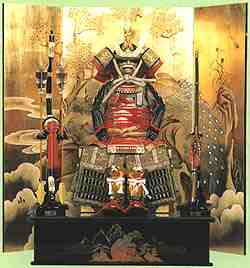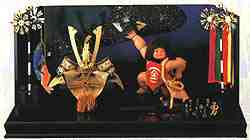| Originally it was called Boy's Festival and was for celebrating boys' growing up, but now it has become a day to celebrate children in general. On this day, families with boys set out dolls for the Boy's Festival, patterned after warriors and heroes, and fly carp streamers as shown to the right. Carp has the strength to even swim up waterfalls and have long been taken as symbols of success in life. The day also features the practice from long ago of taking a bath with flag (a plant), reputed to have medicinal effect, and it is also essential to make an offering of the traditional Japanese confections of rice dumplings wrapped in bamboo leaves and rice cakes wrapped in oak leaves.*1 |  |  |  The upper right is a hero called "Kintaroh", a legendary heroe.*1
@The left is the warrior's helmet.*2
@The left side is a warrior in full armor.*3 |
In ancient time, this festival was introduced from China in 8 th century. Flag was believed to protect plagues and as the japanese pronunciation shohbu for the flag is the same with a phrase meaning "admire heroes", this festival was changed to boy's festival and dolls of heroes were introduced in Edo era.(1600-1868)
*1,*2,*3: These pictures are imported from the site of Doll's shop Hiromori. Their URL was lost now.
|
|
|